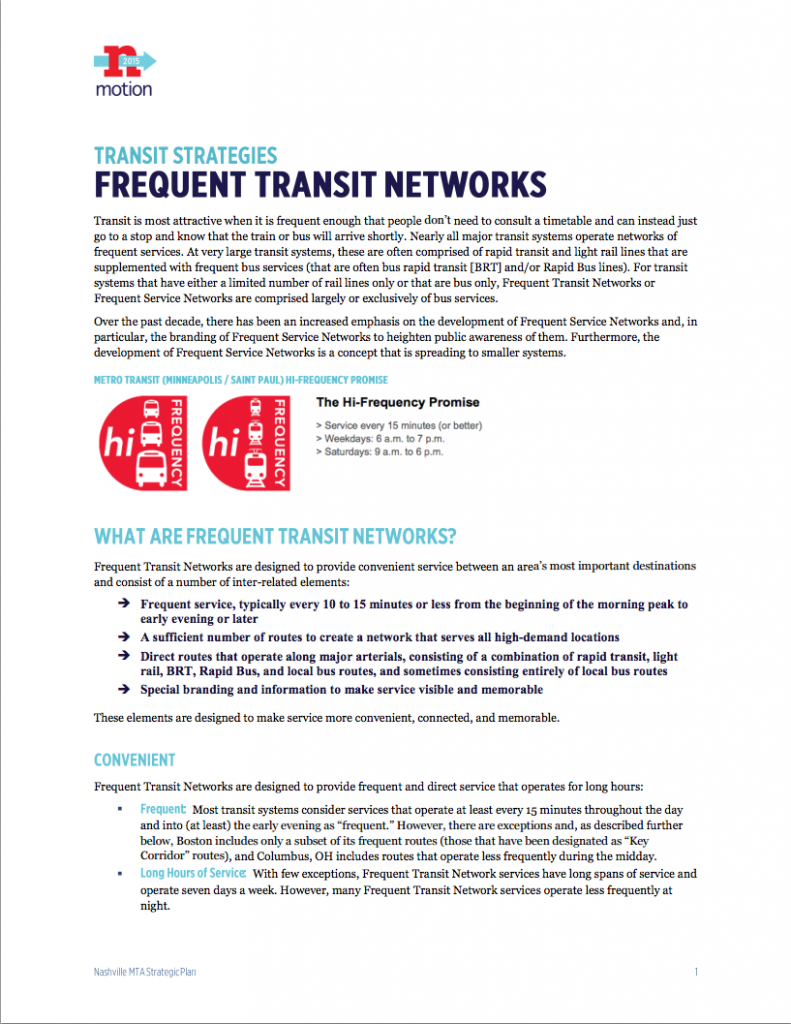
This report in the Transit Strategies Series explores Frequent Transit Networks. Frequent Transit Networks are designed to provide convenient service between an area’s most important destinations and consist of a number of inter-related elements:
- Frequent service, typically every 10 to 15 minutes or less from the beginning of the morning peak to early evening or later
- A sufficient number of routes to create a network that serves all high-demand locations
- Direct routes that operate along major arterials, consisting of a combination of rapid transit, light rail, BRT, Rapid Bus, and local bus routes, and sometimes consisting entirely of local bus routes
- Special branding and information to make service visible and memorable
These elements are designed to make service more convenient, connected, and memorable.

The Greater Nashville Metropolitan area needs park and ride centers/nodes, where commuters can park cars and consolidate in van pools, buses, light rail… Further… All local and regional colleges, community colleges and tech schools should promote using these systems of transit… Belmont and Vanderbilt could help facilitate commuters to maximize transit and cost efficiency.
Nashville needs to focus its bus service on downtown and move out from downtown extending to East Nashville and the 440 corridor West of the Cumberland, including Germantown/Salemtown, Buena Vista, Hope Gardens, Fisk U, Hadley/Washington, TSU, West End, Vandy, Belmont/Hillsboro, Music Row, The Gulch, 12th S, Wedgewood Houston, SoBro.
Instead of Nashville’s current intermittent bus service, Nashville needs a circulator system with buses making stops at each and every stop in a concentrated area. Bus riders should have to wait no more than 10 minutes at any stop. Start by building a reliable bus service with a great phone app and digital times at bus stations on all major routes. All bus routes should run until at least midnight 7 days a week with service until 3am Thurs-Sat. Once you’ve established good service in Central Nashville, you can expand beyond the 440 Loop.
This will not be nearly as expensive as other forms of public transportation and could significantly reduce car traffic in town.
frequent service along many major cross-town connectors seems critical to grow ridership that is not just about commuting to and from downtown for work or leisure. i support the idea of a “university connector” that runs along wedgewood/blakemore, with connections at major radials such as 8th, 12th, 21st, west end, charlotte, etc.
these connectors will help higher-density, residential and mixed-use neighborhoods spread and merge more evenly across the city, which seems to align with the concepts developed through nashville-next.
Old Hickory Blvd on the Brentwood border through Maryland Farms. Fairgrounds should become a hub to get traffic out of downtown through the Nolensville corridor. Clarksville Hwy.
straight up and down charlotte ave
straight up and down Broadway/west end/harding rd
in/out of the Gulch
8Th ave south
12South
more buses on downtown event days/night
MORE on weekends!
Thank you for these suggestions Mary.
Roy,
I like that suggestion a lot. It is the only way, to me, to integrate a frequent transit network that doesn’t require you to go downtown for everything. One thing for sure is that MTA/RTA has to undergo a huge transformation. It’s past time.
I think that everything looks good until the last page, when you remove rapid transit from Franklin Pike. The density on Franklin Pike/8th is about to dwarf 12th when current projects under construction are completed. 8th is four lanes all the way in, while 12th drops to a traffic-filled two lane road that transit will be stuck in. Meanwhile, 8th between Wedgewood and Gale is likely to get a pedestrian and transit-friendly facelift (https://www.nashvillepost.com/blogs/postbusiness/2015/7/23/possible_franklin_road_upgrade_takes_next_step). This seems like the obvious place to implement rapid transit. There will be medium to high density apartments and condos lining 8th by the time any transit plan is implemented.
i agree that frequent service along 8th ave s./franklin pike is important. this corridor is seeing huge development and lots of pedestrian friendly growth, but it is not supported by the current infrastructure.
Please see Rapid Bus route suggestion here:
https://goo.gl/94KUml
This is the celebrated “Loops and Bows” transit system featuring:
1. Rapid Bus service along six major arteries from downtown to the county edge
2. Service to transit hubs that connect with circulators and cross-town routes
3. Loops serve to give access to malls without the need to transfer
4. RTA interconnection with Park and Ride lots that would also serve as a destination for Express Bus Service.
The first Loop would be a connection with the Murfreesboro BRT with the upcoming Nolensville BRT. Ridership will increase much more than with two spurs only going downtown.
No reason why there isn’t already a West End BRT by now; it should serve Bellevue and connect to the Charlotte BRT.
The Loop pattern eliminates the requirement that everyone discharge at Music City Central. Routes could alternate so that someone boarding the Gallatin BRT might let a Bellvue destined BRT go by to grab a Hickory Hollow destined BRT to catch a cross-town bus to the airport. The entire Loop pattern is just one route. You could also extend the ends of the route to add Rapid Bus spurs to Green Hills and Bordeaux.
Bows would serve businesses and neighborhoods and connect at transit hubs for transfers to downtown or outbound.
This is a high volume rapid transit suggestion that would move more people quickly, distribute connections throughout the county rather than just downtown, and stimulate development in areas identified by Nashville Next.
Roy Wellington
The more coverage the better. The swifter the better.